《大学英语语法》课程电子教案(PPT课件)10 Revision、Sample
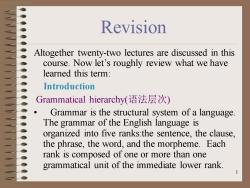
Revision Altogether twenty-two lectures are discussed in this course.Now let's roughly review what we have learned this term: Introduction Grammatical hierarchy(语法层次) Grammar is the structural system of a language. The grammar of the English language is organized into five ranks:the sentence,the clause, the phrase,the word,and the morpheme.Each rank is composed of one or more than one grammatical unit of the immediate lower rank
1 Revision Altogether twenty-two lectures are discussed in this course. Now let’s roughly review what we have learned this term: Introduction Grammatical hierarchy(语法层次) • Grammar is the structural system of a language. The grammar of the English language is organized into five ranks:the sentence, the clause, the phrase, the word, and the morpheme. Each rank is composed of one or more than one grammatical unit of the immediate lower rank

Thus the sentence is a grammatical unit that consists of one or more than one clause;the clause,one or more than one phrase;the phrase,one or more than one ●● word;and the word,one or more than one morpheme. The sentence is the highest rank of grammatical unit while the morpheme is the minimum or the lowest rank.A full sentence can generally be segmented rank by rank down to its smallest constituents--- the morphemes. 2
2 • Thus the sentence is a grammatical unit that consists of one or more than one clause; the clause, one or more than one phrase; the phrase, one or more than one word; and the word, one or more than one morpheme. • The sentence is the highest rank of grammatical unit while the morpheme is the minimum or the lowest rank. A full sentence can generally be segmented rank by rank down to its smallest constituents--- the morphemes
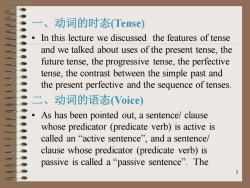
动词的时态(Tense) In this lecture we discussed the features of tense and we talked about uses of the present tense,the future tense,the progressive tense,the perfective tense,the contrast between the simple past and the present perfective and the sequence of tenses. 二、 动词的语态Voice) As has been pointed out,a sentence/clause whose predicator (predicate verb)is active is called an“active sentence”,and a sentence/ clause whose predicator (predicate verb)is passive is called a "passive sentence".The
3 一、动词的时态(Tense) • In this lecture we discussed the features of tense and we talked about uses of the present tense, the future tense, the progressive tense, the perfective tense, the contrast between the simple past and the present perfective and the sequence of tenses. 二、动词的语态(Voice) • As has been pointed out, a sentence/ clause whose predicator (predicate verb) is active is called an “active sentence”, and a sentence/ clause whose predicator (predicate verb) is passive is called a “passive sentence”. The
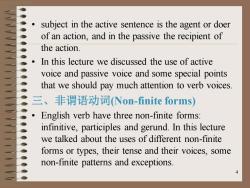
subject in the active sentence is the agent or doer of an action,and in the passive the recipient of the action. In this lecture we discussed the use of active voice and passive voice and some special points that we should pay much attention to verb voices. 三、非谓语动词Non-finite forms) English verb have three non-finite forms: infinitive,participles and gerund.In this lecture we talked about the uses of different non-finite forms or types,their tense and their voices,some non-finite patterns and exceptions
4 • subject in the active sentence is the agent or doer of an action, and in the passive the recipient of the action. • In this lecture we discussed the use of active voice and passive voice and some special points that we should pay much attention to verb voices. 三、非谓语动词(Non-finite forms) • English verb have three non-finite forms: infinitive, participles and gerund. In this lecture we talked about the uses of different non-finite forms or types, their tense and their voices, some non-finite patterns and exceptions
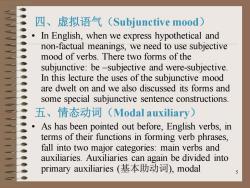
四、虚拟语气(Subjunctive mood) In English,when we express hypothetical and non-factual meanings,we need to use subjective mood of verbs.There two forms of the subjunctive:be-subjective and were-subjective In this lecture the uses of the subjunctive mood are dwelt on and we also discussed its forms and some special subjunctive sentence constructions. 五、情态动词(Modal auxiliary) As has been pointed out before,English verbs,in terms of their functions in forming verb phrases, fall into two major categories:main verbs and auxiliaries.Auxiliaries can again be divided into primary auxiliaries(基本助动词),modal
5 四、虚拟语气(Subjunctive mood) • In English, when we express hypothetical and non-factual meanings, we need to use subjective mood of verbs. There two forms of the subjunctive: be –subjective and were-subjective. In this lecture the uses of the subjunctive mood are dwelt on and we also discussed its forms and some special subjunctive sentence constructions. 五、情态动词(Modal auxiliary) • As has been pointed out before, English verbs, in terms of their functions in forming verb phrases, fall into two major categories: main verbs and auxiliaries. Auxiliaries can again be divided into primary auxiliaries (基本助动词), modal
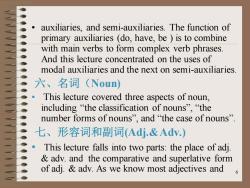
auxiliaries,and semi-auxiliaries.The function of oO primary auxiliaries (do,have,be )is to combine with main verbs to form complex verb phrases And this lecture concentrated on the uses of modal auxiliaries and the next on semi-auxiliaries. 六、名词(Noun) This lecture covered three aspects of noun, including "the classification of nouns","the number forms of nouns",and "the case of nouns". 七、形容词和副词(Adj.&Adv.) This lecture falls into two parts:the place of adj adv.and the comparative and superlative form of adj.adv.As we know most adjectives and
6 • auxiliaries, and semi-auxiliaries. The function of primary auxiliaries (do, have, be ) is to combine with main verbs to form complex verb phrases. And this lecture concentrated on the uses of modal auxiliaries and the next on semi-auxiliaries. 六、名词(Noun) • This lecture covered three aspects of noun, including “the classification of nouns”, “the number forms of nouns”, and “the case of nouns”. 七、形容词和副词(Adj.& Adv.) • This lecture falls into two parts: the place of adj. & adv. and the comparative and superlative form of adj. & adv. As we know most adjectives and
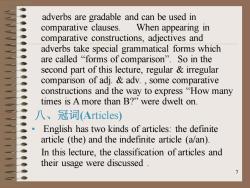
adverbs are gradable and can be used in comparative clauses. When appearing n comparative constructions,adjectives and adverbs take special grammatical forms which are called“forms of comparison”.So in the second part of this lecture,regular irregular comparison of adj.adv.some comparative constructions and the way to express "How many times is A more than B?"were dwelt on. 八、冠词(Articles) English has two kinds of articles:the definite article (the)and the indefinite article (a/an). In this lecture,the classification of articles and their usage were discussed
7 adverbs are gradable and can be used in comparative clauses. When appearing in comparative constructions, adjectives and adverbs take special grammatical forms which are called “forms of comparison”. So in the second part of this lecture, regular & irregular comparison of adj. & adv. , some comparative constructions and the way to express “How many times is A more than B?” were dwelt on. 八、冠词(Articles) • English has two kinds of articles: the definite article (the) and the indefinite article (a/an). In this lecture, the classification of articles and their usage were discussed
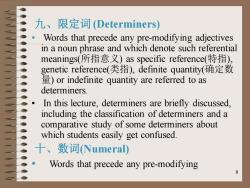
九、限定词(Determiners) Words that precede any pre-modifying adjectives in a noun phrase and which denote such referential meanings(所指意义)as specific reference(特指), genetic reference(类指),definite quantity(确定数 or indefinite quantity are referred to as determiners. In this lecture,determiners are briefly discussed, including the classification of determiners and a comparative study of some determiners about which students easily get confused 十、数词Numera) Words that precede any pre-modifying
8 九、限定词(Determiners) • Words that precede any pre-modifying adjectives in a noun phrase and which denote such referential meanings(所指意义) as specific reference(特指), genetic reference(类指), definite quantity(确定数 量) or indefinite quantity are referred to as determiners. • In this lecture, determiners are briefly discussed, including the classification of determiners and a comparative study of some determiners about which students easily get confused. 十、数词(Numeral) • Words that precede any pre-modifying

adjectives in a noun phrase and which denote such referential meanings((所指意义)as definite quantity(确定数量)or indefinite quantity are referred to as numeral. There are two kinds of numerals:cardinal numeral(one,two,fifty-two etc.)and ordinal numeral(first,tenth,fiftieth etc.).Uses of different numerals in this lecture were discussed 十一、介词(Preposition) Prepositions are a class of structural words that indicate various semantic relations between words or expressions.Prepositions are usually divided into the following three types:simple prepositions,compound
9 adjectives in a noun phrase and which denote such referential meanings(所指意义) as definite quantity(确定数量) or indefinite quantity are referred to as numeral. There are two kinds of numerals: cardinal numeral(one, two, fifty-two etc.) and ordinal numeral( first, tenth, fiftieth etc.). Uses of different numerals in this lecture were discussed. 十一、介词(Preposition) • Prepositions are a class of structural words that indicate various semantic relations between words or expressions. Prepositions are usually divided into the following three types: simple prepositions, compound
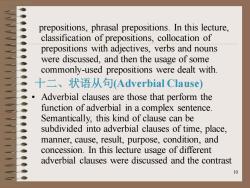
prepositions,phrasal prepositions.In this lecture, classification of prepositions,collocation of prepositions with adjectives,verbs and nouns were discussed,and then the usage of some commonly-used prepositions were dealt with. 十二、状语从句(Adverbial Clause) Adverbial clauses are those that perform the function of adverbial in a complex sentence. Semantically,this kind of clause can be subdivided into adverbial clauses of time,place, manner,cause,result,purpose,condition,and concession.In this lecture usage of different adverbial clauses were discussed and the contrast 10
10 prepositions, phrasal prepositions. In this lecture, classification of prepositions, collocation of prepositions with adjectives, verbs and nouns were discussed, and then the usage of some commonly-used prepositions were dealt with. 十二、状语从句(Adverbial Clause) • Adverbial clauses are those that perform the function of adverbial in a complex sentence. Semantically, this kind of clause can be subdivided into adverbial clauses of time, place, manner, cause, result, purpose, condition, and concession. In this lecture usage of different adverbial clauses were discussed and the contrast
按次数下载不扣除下载券;
注册用户24小时内重复下载只扣除一次;
顺序:VIP每日次数-->可用次数-->下载券;
- 《大学英语语法》课程电子教案(PPT课件)01 动词的语态.ppt
- 《大学英语语法》课程电子教案(PPT课件)00 Introduction、The use of simple present.ppt
- 上海交通大学:《日语》课程教学资源(教学大纲)日本课程教学大纲汇编 Japanese Course Outline.pdf
- 吉林大学:《大学英语》课程电子教案(PPT课件)大学英语(一)第八单元(第66-72讲).ppt
- 吉林大学:《大学英语》课程电子教案(PPT课件)大学英语(一)第七单元(第58-65讲).ppt
- 吉林大学:《大学英语》课程电子教案(PPT课件)大学英语(一)第六单元(第50-57讲).ppt
- 吉林大学:《大学英语》课程电子教案(PPT课件)大学英语(一)第五单元(第42-49讲).ppt
- 吉林大学:《大学英语》课程电子教案(PPT课件)大学英语(一)第四单元(第34-41讲).ppt
- 吉林大学:《大学英语》课程电子教案(PPT课件)大学英语(一)第三单元(第25-33讲).ppt
- 吉林大学:《大学英语》课程电子教案(PPT课件)大学英语(一)第二单元(第13-24讲).ppt
- 吉林大学:《大学英语》课程电子教案(PPT课件)大学英语(一)第一单元(第1-12讲).ppt
- 上海海洋大学:外国语学院英语专业课程教学大纲汇编(2022年版).pdf
- 上海海洋大学:外国语学院日语专业课程教学大纲汇编(2022年版).pdf
- 上海海洋大学:外国语学院大学外语类课程教学大纲汇编(2022年版).pdf
- 上海海洋大学:外国语学院朝鲜语专业课程教学大纲汇编(2022年版).pdf
- 上海海洋大学:外语学院2018版课程教学大纲汇编(综合与通识教育课).pdf
- 上海海洋大学:外语学院2018版课程教学大纲汇编(专业实践课).pdf
- 上海海洋大学:外语学院2018版课程教学大纲汇编(专业理论课).pdf
- 上海海洋大学:外语学院2011年版课程教学大纲汇编(目录).pdf
- 上海海洋大学:外语学院2011年版课程教学大纲汇编(正文).pdf
- 《大学英语语法》课程电子教案(PPT课件)02 完成时的用法、一般过去时与现在完成时的区别、时态的呼应.ppt
- 《大学英语语法》课程电子教案(PPT课件)03 非谓语动词(Non-finite forms).ppt
- 《大学英语语法》课程电子教案(PPT课件)04 虚拟语气(subjunctive mood)、情态动词(modal auxiliary).ppt
- 《大学英语语法》课程电子教案(PPT课件)05 名词(Noun)、形容词和副词(Adj.& Adv.)、冠词.ppt
- 《大学英语语法》课程电子教案(PPT课件)06 限定词(Determiners)、数词(numeral).ppt
- 《大学英语语法》课程电子教案(PPT课件)07 介词(preposition)、状语从句(Adverbial Clause)、定于从句(Attributive Clause)、名词性从句(Nominal Clauses)、主谓一致(Subject-verb Concord).ppt
- 《大学英语语法》课程电子教案(PPT课件)08 否定(Negation)、倒装(Inverted Order)、反意疑问句(tag question).ppt
- 《大学英语语法》课程电子教案(PPT课件)09 替代(substitution)、省略(Ellipsis)、It- 句型(“It” patterns)、直接引语和间接引语(Direct and Indirect Speech).ppt
- 吉林大学:《英语听说》课程电子教案(PPT课件)unit12 communuication..ppt
- 吉林大学:《英语听说》课程电子教案(PPT课件)unit13 family.ppt
- 吉林大学:《英语听说》课程电子教案(PPT课件)unit14 Transportation.ppt
- 吉林大学:《英语听说》课程电子教案(PPT课件)unit15 Service and economy.ppt
- 吉林大学:《英语听说》课程电子教案(PPT课件)unit18-19 UNIVERSITY LIFE.ppt
- 吉林大学:《英语听说》课程电子教案(PPT课件)unit20 Special English 1.ppt
- 吉林大学:《英语听说》课程电子教案(PPT课件)unit22 Special English.ppt
- 吉林大学:《英语听说》课程电子教案(PPT课件)unit23 Special English.ppt
- 吉林大学:《英语听说》课程电子教案(PPT课件)unit1-unit11(主讲人:董育英、寇晓虹).ppt
- 吉林大学:《英语听说》课程电子教案(PPT课件)unit16 At the Hotel 1.ppt
- 吉林大学:《英语听说》课程电子教案(PPT课件)unit21 Special English 2.ppt
- 吉林大学:《英语听说》课程电子教案(PPT课件)unit17 At the Hotel 2.ppt
